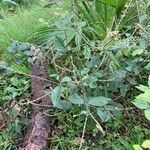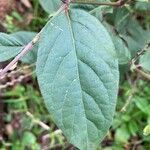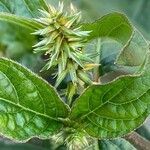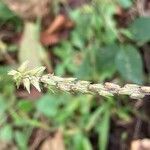Herb 0.3–1.5 m high. Leaves: petiole 2–20 (–30) mm long; lamina ovate to narrowly ovate, (15–) 25–100 (–220) m long, (5–) 10–80 (–100) mm wide, base cuneate, margin entire, apex acuminate; dark to olive green above, lighter green below, hairs densely to sparsely covering both sides. Inflorescence a terminal or axillary spike, 3–10 (–20) cm long; peduncle (4–) 10–40 (–60) mm long. Bract ovate to broadly ovate, (2.1–) 3–3.5 mm long, with a few short wavy white hairs on margins. Bracteole wing sides separate from vein, wing shaped, 0.5–1.4 mm long; vein extrudes as spinescent tip, 2–4 mm long; wing entire to ciliate. Tepals 5, narrow ovate, green to violet, with apex acute, not spinescent, 4.0–7.0 mm long, 1.2–2.1 mm wide, glabrous. Stamens: filaments 1.1–2.0 mm long; anthers 0.25–0.4 mm long; pseudostaminodes rectangular, 0.5–1 mm long, 0.2–0.5 mm high, with apex dentate to irregular, sometimes with a rudimentary dorsal scale; appendage absent. Style 0.8–2 mm long. Fruit an indehiscent utricle, cylindrical, (1.7–) 2–3 mm long, 0.8–1.7 mm wide. Seed ellipsoid to ovoid, 2–2.5 mm long, 0.8–1.6 mm wide, reddish brown, smooth with round cells.
Herbs perennial, 70-120 cm tall. Stem green or tinged purple, angulate or quadrangular, appressed or spreading pubescent, or nearly glabrous; branches opposite. Petioles 0.5-3 cm, hairy; leaf blade elliptic or elliptic-lanceolate, rarely oblanceolate, 4.5-12 × 2-7.5 cm, both surfaces annexed or spreading pubescent, base cuneate or broadly cuneate, caudate. Spikes terminal or axillary, 3-5 cm; rachis 1-2 cm, white hairy. Flowers dense, ca. 5 mm. Bracts reflexed after anthesis, broadly ovate, 2-3 mm, apex acuminate; bracteoles 2.5-3 mm, spiny, base 2-parted, apex curved. Tepals shiny, lanceolate, 3-5 mm, with a midvein, apex acute. Stamens 2-2.5 mm; pseudostaminodes slightly serrulate, apex rounded. Utricles yellowish brown, shiny, oblong, 2-2.5 mm, smooth. Seeds light brown, oblong, ca. 1 mm. Fl. Jul-Sep, fr. Sep-Oct. 2n = 42, 84*.
A herb. It can be erect or hang over. It grows to 1 m tall. The leaves are oval and 5-20 cm long by 1-8 cm wide. The leaf stalk is 5-15 mm long. The leaf tapers towards the tip. The leaves are densely hairy. The flower cluster is at the end of the branches and in the upper leaf axils. The flower cluster is 4-12 cm long. There is a show of violet colour during flowering. The fruit is 2-2.5 mm long. The seed is 1.5 mm long.
Leaves comparatively large, turning black-green on drying
An erect forest herb, 2–4 ft. high
Flowers glistening green.




